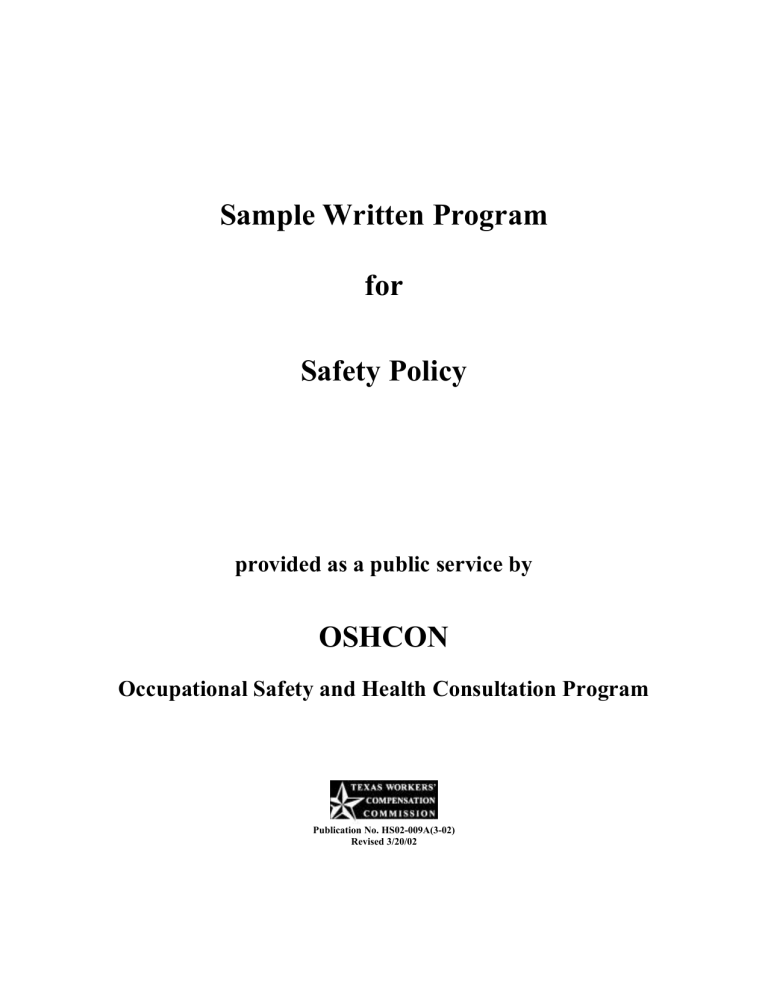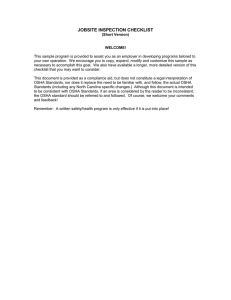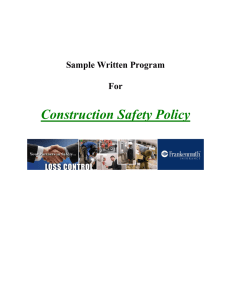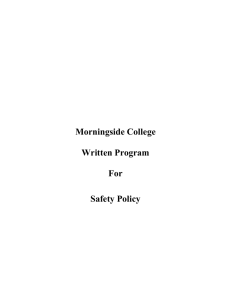
Sample Written Program for Safety Policy provided as a public service by OSHCON Occupational Safety and Health Consultation Program Publication No. HS02-009A(3-02) Revised 3/20/02 1910, 1926 Safety Policy The following safety policy is provided only as a guide to assist employers and employees in complying with the requirements of 29 CFR 1910 and 1926, as well as to provide other helpful information. It is not intended to supersede the requirements of the standards. An employer should review the standards for particular requirements which are applicable to their individual situation and make adjustments to this program that are specific to their company. An employer will need to add information relevant to their particular facility in order to develop an effective, comprehensive program. 2 1910, 1926 Safety Policy Table of Contents I. Objective II. Policy III. Applicability IV. Implementation V. Administration VI. Reporting Injuries VII. Notifications VIII. Basic Safety Rules IX. Enforcement of Safety Policy X. Attachments A. Job Safety Checklist B. Safety Equipment Checklist C. Safety Meeting Report D. Employee Acknowledgment 3 (Company Name) Safety Policy I. OBJECTIVE The Safety Policy of Company Name is designed to comply with the Standards of the Occupational Safety and Health Administration, and to endeavor to maintain a safe and injury/illness free workplace. A copy of the OSHA Safety and Health Standards 1926 and 1910 are available for all employees= use and reference. These Standards shall be available in the home office at all times and will be sent to the jobsite on request. Compliance with the following Safety Policy and all items contained therein is mandatory for all employees of the company. The authorization and responsibility for enforcement has been given primarily to the Responsible Person . The Other Responsible Person(s) share in this responsibility as well. II. POLICY It is company policy that accident prevention be a prime concern of all employees. This includes the safety and well being of our employees, subcontractors, and customers, as well as the prevention of wasteful, inefficient operations, and damage to property and equipment. III. APPLICABILITY This Safety Policy applies to all employees of Company Name , regardless of position within the company. The Safety Rules contained herein apply to all subcontractors and anyone who is on a company project site. Every employee is expected to comply with the Safety Policy, as well as OSHA Health and Safety Standards. IV. IMPLEMENTATION This Safety Policy supports six fundamental means of maximum employee involvement: A. B. C. D. E. F. Management commitment to safety. Weekly tool box safety meetings at all jobsites. Effective job safety training for all categories of employees. Job hazard analysis provided to all employees. Audio and/or visual safety presentations given at jobsites by Responsible Person Various incentive awards for exemplary safety performance. 4 . The Responsible Persons will meet at least once a month to evaluate all areas of safety and make recommendations to the company president. V. ADMINISTRATION The Safety Policy will be carried out according to guidelines established and published in this and other related procedures. Specific instructions and assistance will be provided by Responsible Person as requested. Each supervisor will be responsible for meeting all of the requirements of the Safety Policy, and for maintaining an effective accident prevention effort within his or her area of responsibility. Each supervisor must also ensure that all accidents are thoroughly investigated and reported to Responsible Person(s) on the same day of the occurrence. VI. REPORTING OF INJURIES All employees will be held accountable for filling out a ANotice of Injury Form" immediately after an injury occurs, even if medical treatment is not required. (Notice must be made at or near the time of the injury and on the same day of the injury.) Employees must report the injury to their supervisor/leadman/foreman/superintendent/project manager, etc. A casual mentioning of the injury will not be sufficient. Employees must let their supervisor know: A. B. C. D. E. How they think they hurt themselves. What they were doing at the time. Who they were working with at the time. When and where it happened. Other pertinent information that will aid in the investigation of the incident. Failure to report an injury immediately (meaning at or near the time of the injury and on the same day of the injury) is a violation of the Safety Policy, and they may result in immediate termination, in accordance with company policy. VII. NOTIFICATIONS A. In Case of Serious Injury or Death After the injured has been taken to the hospital, the leadman/foreman/supervisor shall notify the main office and Responsible Person(s) as soon as possible. Statements from witnesses shall be taken. Statements are to be signed by witnesses and should include the time and date. Photographs of the area where the incident occurred and any other relevant items are to be taken. Responsible Person will assist in the investigation. The completed accident report form will sent to the main office. 5 B. In Case of Inspection by OSHA Inspector The leadman/foreman/supervisor must notify Responsible Person(s) that an OSHA Inspector is on the jobsite. It is the responsibility of all employees to make the inspector=s visit on the jobsite as pleasant and timely as possible. VIII. BASIC SAFETY RULES A. Compliance with applicable federal, state, county, city, client, and company safety rules and regulations is a condition of employment. B. All injuries, regardless of how minor, must be reported to your supervisor and the Safety Office immediately. An employee who fails to fill out a "Notice Of Injury Form" and send it to the Safety Office can be issued a safety violation notice and may be subject to termination, in accordance with company policy. In the event of an accident involving personal injury or damage to property, all persons involved in any way will be required to submit to drug testing. C. Hard hats will be worn by all employees on the project site at all times. The bill of the hard hat will be worn in front at all times. Alterations or modifications of the hat or liner is prohibited. Crane operators, when in an enclosed cab, have the option of not wearing a hard hat due to the possible obstruction of view. D. Safety glasses will be worn as the minimum-required eye protection at all times. Additional eye and face protection such as mono-goggles and face shields are required for such operations as grinding, jack hammering, utilizing compressed air or handling chemicals, acids and caustics. Burning goggles for cutting, burning or brazing and welding hoods for welding, etc., are required. E. Fall Protection Requirements 1. Full body harnesses and lanyards shall be worn and secured any time there is a fall hazard of more than six (6) feet. 2. Lifelines shall be erected to provide fall protection where work is required in areas where permanent protection is not in place. Horizontal lifelines shall be a minimum of 2-inch diameter wire rope. Vertical lifelines shall be 3/4 inch manila rope or equivalent and shall be used in conjunction with an approved rope grab. 3. Structural steel erectors are required to "hook up" with full body harness and lanyard. 4. Employees using lanyards to access the work or position themselves on a wall or column, etc., must use an additional safety lanyard for fall protection. 5. Manlifts must be used properly. As soon as an employee enters an articulating boom lift and before the lift is started, the employee must put on the harness and 6 attach the lanyard to the lift. Employees are not required to wear harnesses on scissor lifts. F. Clothing must provide adequate protection to the body. Shirts must have at least a tee sleeve. Shirts with sleeves and long pants will be worn at all times. No shorts are to be worn on projects. All employees, except welders and burners, must tuck shirt tails inside trousers. Burners and welders will not be permitted to wear polyester or nylon clothing. Sturdy work boots with rigid, slip resistant soles are required. No clogs, tennis shoes or loafers are permitted. Steel-toed tennis shoes with the ANSI label are the only alternative to the leather work boot. G. All personnel will be required to attend safety meetings as stipulated by project requirements in order to meet OSHA Safety Standards. H. Firearms, alcoholic beverages or illegal drugs are not allowed on company property or in company vehicles at any time. When drugs are prescribed by a physician, the Responsible Person must be informed. The use or possession of illegal drugs or alcoholic beverages on the jobsite will result in immediate termination. I. Housekeeping shall be an integral part of every job. Supervisors\foremen\leadmen and employees are responsible for keeping their work areas clean and hazard-free. Clean up is required when a job is finished at the end of the day. J. Burning and cutting equipment shall be checked daily before being used. Flash back arresters shall be installed at the regulators on both oxygen and LP bottles. All gas shall be shut off and hoses disconnected from bottles and manifolds at the end of the work day. Caps shall be replaced on bottles when gauges are removed. When gauges are removed and caps replaced, the oxygen and LP bottles shall be separated into storage areas no less than 20 feet apart with a ANo Fire or Smoking" sign posted and a fire extinguisher readily available. Makeshift field repairs will not be allowed. K. Drinking water containers are to be used for drinking water and ice only. Tampering with or placing items such as drinks in the water cooler will result immediate termination. The "common drinking cup" is not allowed. Only disposable cups will be used. L. All tools whether company or personal, must be in good working condition. Defective tools will not be used. Examples of defective tools include chisels with mushroomed heads, hammers with loose or split handles, guards missing on saws or grinders, etc. M. All extension cords, drop cords, and electrical tools shall be checked, properly grounded with ground fault interrupters (GFI=s), and color-coded by a designated 7 competent person each month. This shall be part of the assured grounding program. Cords and equipment that do not meet requirements shall be immediately tagged and removed from service until repairs have been made. N. AHorseplay" on the jobsite is strictly prohibited. Running on the jobsite is allowed only in extreme emergencies. O. Glass containers or bottles of any kind are not permitted on jobsites or in company vehicles. P. The jobsite speed limit is 10 MPH. No employee is permitted to ride in the bed of a truck standing up or sit on the outside edges of a truck. Employees must be sitting down inside the truck or truck bed when the vehicle is in motion. Riding as a passenger on equipment is prohibited unless the equipment has the safe capacity for transporting personnel. Q. Adequate precautions must be taken to protect employees and equipment from hot work such as welding or burning. Fire extinguishing equipment shall be no further than 50 feet away from all hot work. Used fire extinguishers must be returned to (Responsible person) to be recharged immediately. Use of welding blinds is required in high traffic areas. R. All scaffolding and work platforms must be built and maintained in accordance with OSHA specifications. All ladders must be in safe condition without broken rungs or split side rails. Damaged ladders shall be removed from service. Ladders shall be secured at the top and bottom and extend three (3) feet past the working surface. Metal ladders around electrical work are prohibited. A step ladder shall never be used as an extension ladder. A step ladder must only be used when fully opened with braces locked. S. Crowfoot connections on air hoses shall be wired to prevent accidental disconnection. Compressed air shall not be used to dust off hands, face or clothing. T. Report all unsafe conditions and near accidents to corrective action can be taken. U. All floor openings or excavations shall be barricaded on all sides to ensure employees are aware of the hazards. Floor holes shall be covered, with the covers secured and clearly marked. V. W. Warning signs, barricades, and tags will be used to fullest extent and shall be obeyed. Scaffold Tag System 8 Responsible Person so 1. 2. 3. 4. Green tags are to be placed on 100 percent complete scaffolds with all braces, locks and hand, mid, and toe rails in place before use. Yellow tags indicate incomplete scaffolds. If scaffold is missing a hand, mid, or toe board, it must have a yellow tag and employees on it must be tied off at all times. Red tags indicate scaffolds that are in the process of either being erected or disassembled. These scaffolds are not to be used at any time. Scaffold tags should be placed in a highly visible location on the scaffolds for all employees to see. X. All OSHA Safety Standards will be followed for job processes requiring respiratory protection. SEE RESPIRATORY PROTECTION PROGRAM. Y. All OSHA Safety Standards will be followed during excavation. SEE EXCAVATION PROGRAM. Z. All OSHA Safety Standards concerning confined space entry will be followed. SEE CONFINED SPACE PROGRAM. AA. All OSHA Safety Standards concerning lockout/tagout of energized equipment will be followed. SEE LOCKOUT/TAGOUT PROGRAM BB. All OSHA Safety Standards will be followed for job processes requiring fall protection. SEE FALL PROTECTION PROGRAM. IX. ENFORCEMENT OF SAFETY POLICY Safety violation notice(s) shall be issued to any employee, subcontractor, or anyone on the jobsite violating the safety rules or regulations by Responsible Person . A. B. C. Any violation of safety rules can result in suspension or immediate termination. Any employee receiving three (3) written general violations within a six (6) month period shall be terminated. Issuance of a safety violation notice for failure to use fall protection or for failure to report a job injury (at the time of the injury) may result in immediate termination, in accordance with company policy. It is understood that Company Name is not restricting itself to the above rules and regulations. Additional rules and regulations as dictated by the job will be issued and posted as needed. 9 ATTACHMENT A JOB SAFETY CHECKLIST The following Job Safety Checklist has been condensed and edited from the Occupational Safety and Health Act, Part 1926, Construction Safety and Health Regulations. A. Safety Rules _________ Hard hats and safety glasses worn. _________ Shirts with sleeves worn. _________ Work shoes worn. _________ Subcontractors' personnel hold safety meetings as indicated by project requirements in accordance with OSHA Safety Standards. _________ Work areas safe and clean. _________ Safety mono-goggles/face shields worn when circumstances warrant. _________ Electrical cords and equipment properly grounded with GFI's in place and checked by a competent person. _________ No use of alcoholic beverages or controlled substances. _________ Subcontractors provide fall protection for their employees in accordance with OSHA Safety Standards. _________ All scaffolds built to specifications as established by OSHA. _________ Excavation/trenches sloped or shored as established by OSHA. _________ Drug testing of employees involved in accident(s) resulting in personal injury or property damage. B. Recordkeeping _________ OSHA poster "Safety and Health Protection on the Job" posted. _________ OSHA " 200 Log or Occupational Injuries and Illnesses" posted during the month of February only. _________ Hard hat sign posted in a conspicuous manner. _________ Weekly safety meeting sign-in logs maintained in a folder with a copy forwarded to the main office weekly. C. Housekeeping and Sanitation _________ General neatness. _________ Regular disposal of trash. _________ Passageways, driveways, and walkways clear. _________ Adequate lighting. _________ Oil and grease removed. _________ Waste containers provided and used. 10 _________ Adequate supply of drinking water. _________ Sanitary facilities adequate and clean. _________ Adequate ventilation. D. First Aid _________ First aid stations with supplies and equipment. The expiration dates of supplies checked monthly. Expired supplies discarded. _________ Trained first aid personnel. _________ Injuries promptly and properly reported. E. Personal Protective Equipment _________ Hard hats. _________ Hearing protection. _________ Eye and face protection. _________ Respiratory protection. _________ Fall protection. F. Fire Protection _________ Fire extinguishers charged and identified. _________ ANo Smoking@ signs posted. _________ Flammable and combustible material storage area. _________ Fuel containers labeled. G. Hand and Power Tools _________ Tools inspected. _________ Power tools properly guarded. _________ Safety guards in place. H. Welding & Cutting _________ Compressed gas cylinders secured in vertical position. _________ Hoses inspected. _________ Cylinders, caps, valves, couplings, regulators, and hoses free of oil and grease. _________ Caps on cylinders in storage in place. _________ Flash back arresters in place. _________ Welding screens in place. _________ Fuel and oxygen cylinders separated in storage. 11 I. Electrical _________ All portable tools and cords properly grounded [Ground Fault Interrupters (GFI=s) properly installed]. _________ Daily visual inspection of caps, ends and cords for deformed or missing pins, insulation damage and internal damage. _________ Tests of cords, tools and equipment for continuity and correct attachment of the equipment grounding connector (GFI) to the proper terminal made every month and: 1. Prior to first use. 2. Prior to return to service after repairs. 3. Prior to return to service after incident that may have caused damage to cord or equipment. _________ Cords and equipment not meeting requirements immediately tagged and removed from service until repairs have been made. J. Ladders _________ Inspected at regular intervals. _________ No broken or missing rungs or steps. _________ No broken or split side rail. _________ Extend at least 36 inches above landing and be secured. _________ Side rails of 2 x 4 up to 16 feet, or 3 x 6 over 16 feet. K. Scaffolding _________ Inspected at regular intervals. _________ Footings are a sound ridge and capable of carrying maximum intended load. _________ Tied into building vertically and horizontally at 14 foot intervals. _________ Properly cross-braced. _________ Proper guardrails and toe boards. _________ Scaffold planks capable of supporting at least four (4) times the maximum intended load. _________ No unstable objects such as concrete blocks, boxes, etc., used as scaffold foundations. _________ Use of OSHA Scaffold Tagging Program. L. Guardrails, Handrails and Covers _________ Guardrails, handrails and covers installed wherever there is danger of employees or materials falling through floors, roots or wall openings and shall be guarded on all exposed sides. _________ Posts at least 2 x 4 stock and spaced no more than eight (8) feet apart. 12 _________ Top rail 42 inches above the floor and of 1 x 4 stock. _________ Intermediate rail 21 inches above the floor and of 1 x 4 stock. _________ Guardrail assemblies around floor openings equipped with toe boards. Toe boards at least four (4) inches above the floor level with no more than 1/4 inch clearance above the floor level, when there are employees below or when conditions dictate. _________ Hole covers permanently attached to the floor or structure and identified with a hole cover sign stenciled with the word "Danger". Hole covers for holes two (2) inches or greater in diameter made of at least 3/4 inch plywood or heavier. M. Material Hoists _________ Inspected at regular intervals. _________ Operating rules posted at operators station. _________ "No Rider" signs prominently posted at all stations. _________ All entrances properly protected. _________ All entrance bars and gates painted with diagonal contrasting stripes. _________ Experienced operators. _________ Current crane certification inspection sticker and papers on the rig. N. Motor Vehicles _________ Lights, brakes, tires, horn, etc., inspected at regular intervals. _________ No overloaded vehicles. _________ Trash trucks have covers. _________ No riding on the edge of pickup truck beds. _________ No riding on concrete trucks, loaders, backhoes, etc. _________ Functioning back-up alarms on loaders, tractors, backhoes, etc. _________ Fire extinguishers installed and readily available. _________ Seat belts worn at all times. O. Material Storage and Handling _________ Material at least two (2) feet from edge of excavation site. _________ Proper temperature and moisture levels for safe storage of materials to prevent deterioration or volatile hazards within the storage area. _________ Inventory maintained and inspected frequently. _________ Proper protective gear worn when handling chemicals. P. Concrete, Concrete Forms and Shoring _________ Full body harnesses as positioning devices for employees tying rebar greater than six (6) feet above adjacent working surface have _________ Automatic shut-off switches on trowel machines. 13 _________ No riding on concrete buckets or flying forms. _________ All forms properly shored. _________ Single post shores braced horizontally. Q. Use of Cranes and Derricks _________ Prohibition of the use of cranes or derricks to hoist employees on a personal platform except in the situation where no safe alternative is possible. 14 ATTACHMENT B SAFETY EQUIPMENT CHECKLIST The following is a list of Safety Equipment that should be on the job, if required, or available from the Responsible person at all times. Equipment should be checked at intervals in accordance with the applicable OSHA Safety Standards by the Superintendent to ensure that all required equipment is present and in good condition. _________ Safety goggles, shields, and glasses. _________ Hearing protection. _________ Respirators. _________ Hard hats. _________ Fire extinguishers (properly charged). _________ First aid kit (check list inside kit). _________ Stretcher or stroke litter (tool room). _________ Welding masks and goggles. _________ Storage racks for compressed gases. _________ Guards on all power tools. _________ Trash barrels. _________ OSHA forms posted. _________ Company "Safety Policy" packet posted. _________ Company "Hazardous Communication Program" packet posted. _________ Emergency vehicle (vehicle designated to carry injured to hospital). 15 ATTACHMENT C SAFETY MEETING REPORT A safety meeting report is signed to indicate attendance. The form has room for employees to sign after attending their weekly safety meeting. This form shall be filled out for each jobsite safety meeting that is held. After completion of the form, make a copy to maintain at each jobsite and return the signed original copy to the main office. Safety Meeting Date:________________________ Topic:___________________________________ Safety Meeting Conducted By:______________________________________________________________ Employee Name (printed) Employee Signature 16 Job Title ATTACHMENT D EMPLOYEE ACKNOWLEDGMENT I state that I have attended the safety orientation, and have read and received a copy of the Company Name safety rules and regulations. I further state that I understand these rules and acknowledge that compliance with the safety rules and regulations is a condition of employment. If I violate the safety rules or fail to report an injury to my supervisor immediately, I understand that I am subject to termination, in accordance with company policy. __________________________________________ EMPLOYEE SIGNATURE __________________________________________ DATE __________________________________________ Responsible Person SIGNATURE __________________________________________ DATE cc: Supervisor 17




